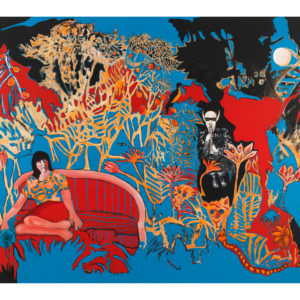A kiss. A punch. A body braced for impact. The paintings of Rosalyn Drexler exude uncanny stillness, anticipation and, frequently, the dread of imminent violence. Moments of intimacy and conflict are frozen, sliced and readied for examination — excerpts from narratives whose conclusions can only be guessed.
This spring, the Mildred Lane Kemper Art Museum at Washington University in St. Louis will present “Rosalyn Drexler: Who Does She Think She Is?”, the first full-career retrospective for the multitalented artist. Surveying six decades of work, the exhibition features major paintings and collages alongside rarely seen early sculptures. Also included are books, photographs and other materials documenting Drexler’s wide-ranging and colorful career as a novelist, playwright and — briefly — professional wrestler.
Born in the Bronx in 1926, the self-trained Drexler began creating brightly hued sculptural assemblages in the mid-1950s. She received critical praise for her first solo exhibition, at New York’s short-lived but influential Reuben Gallery, which also showcased such experimental artists as Claes Oldenburg, Allan Kaprow and Lucas Samaras. But, in 1961, the gallery closed and Drexler, watching as male colleagues secured representation elsewhere, turned her attention to painting — a practice she would continue intermittently until the present day.

Drexler appropriated figures and subjects from a wide variety of popular sources, especially print media and film. Indeed, her use of cinematic imagery would anticipate the work of Pictures Generation artists such as Sarah Charlesworth and Robert Longo. Yet Drexler’s work also emphasized a sense of material and physicality. Rather than project and trace images onto canvas, as would some of her Pop Art contemporaries, several of whom had commercial backgrounds, Drexler cropped, enlarged, printed and collaged her source material, then applied acrylics on top. This method allowed Drexler to envelop and erase the photomechanical image while paradoxically imbuing it with a tactile sense of the artist’s hand.
Early works such as “Lovers” (1963) and “Self-Portrait” (1964) are striking for their electric palettes and critical exploration of gender roles. “Embrace” (1964) and “Love in the Green Room” (1963) play with Hollywood romantic conventions while “Rape” (1962), “I Won’t Hurt You” (1964) and “Put it This Way” (1963) — the latter of which depicts a woman recoiling from a man’s slap — expose undercurrents of abuse and domestic violence pervasive in popular media. Yet Drexler also captures moments of strength and defiance. In “Self-Defense” (1963), an armed woman knees her presumed attacker to the floor while “The Winner” (1965) raises her arms in triumph.
Works such as “Sorry About That” (1966), “Lear Executive” (1967) and “Decked Him” (1991) subvert and critique the iconography of male authority and power. With their liquid blacks and acid yellow backgrounds, “The Syndicate” (1964) and “Nuclear Blast/Amusement Park” (1998) are twin studies in malevolent ambiguity. “This is My Hell” (2013), one of Drexler’s most recent works, depicts a woman hoisted aloft by two dark-suited men, their heads framed by licks of fire, who seem to carry her toward the flames.

About the artist
Drexler’s paintings can be found in the collections of the Whitney Museum of American Art, Wadsworth Atheneum Museum of Art, Hirshhorn Museum and Sculpture Garden and Walker Art Center, among others.
In addition, she won the first of three Obie Awards for her one-act musical “Home Movies” (with music by Al Carmines), which premiered at the Judson Poets’ Theater in 1964. For several months in 1950, she toured the United States as part of the women’s wrestling circuit, performing as “Rosa Carlo, the Mexican Spitfire” — an experience that later inspired her novel “To Smithereens” (1972), as well as Andy Warhol’s series of silkscreen portraits “Album of a Mat Queen” (1962).
Drexler’s other novels include “I Am the Beautiful Stranger” (1965), “One or Another” (1970), “Art Does (Not!) Exist” (1996) and “Vulgar Lives” (2007). In addition, she has published five novels under the pseudonym Julia Sorel, including a novelization of the film “Rocky” (1976), and she was part of the team of writers who received an Emmy award in 1974 for Lily Tomlin’s television special “Lily.”
Organizers and catalog
“Rosalyn Drexler: Who Does She Think She Is?” was organized by the Rose Art Museum at Brandeis University and co-curated by Katy Siegel and Caitlin Julia Rubin. Its presentation at the Mildred Lane Kemper Art Museum is curated by Allison Unruh, associate curator.
A fully illustrated catalog, the most comprehensive documentation of Drexler’s work to date, accompanies the exhibition. Edited by Siegel, who also authors the introduction, the volume includes texts by Unruh and Rubin as well as Hilton Als, Jonathan Lethem, Michael Lobel and Kalliopi Minioudaki. Also featured are excerpts from Drexler’s plays and novels.
Support for the exhibition is provided by: the William T. Kemper Foundation; the Missouri Arts Council, a state agency; the Regional Arts Commission; the Hortense Lewin Art Fund; and members of the Kemper Art Museum.
Mildred Lane Kemper Art Museum
“Rosalyn Drexler: Who Does She Think She Is?” opens at the Kemper Art Museum with a public reception from 7 to 9 p.m. Friday, Feb. 10 and remains on view through April 17. At 1 p.m. Saturday, Feb. 11, the museum will host a gallery talk with Unruh and exhibition co-curator Caitlin Julia Rubin, assistant curator at the Rose Art Museum, Brandeis University. Other events will include a film series (March 7-9), dramatic readings of two of Drexler’s plays (March 24) and a collage workshop inspired by her practice (March 27).
The museum is located on Washington University’s Danforth Campus, near the intersection of Skinker and Forsyth boulevards. Regular hours are 11 a.m.-5 p.m. daily except Tuesdays and 11 a.m.-8 p.m. the first Friday of the month. The museum is closed Tuesdays.
For more information, call 314-935-4523; visit kemperartmuseum.wustl.edu; or follow the museum on Facebook, Twitter and Instagram.









